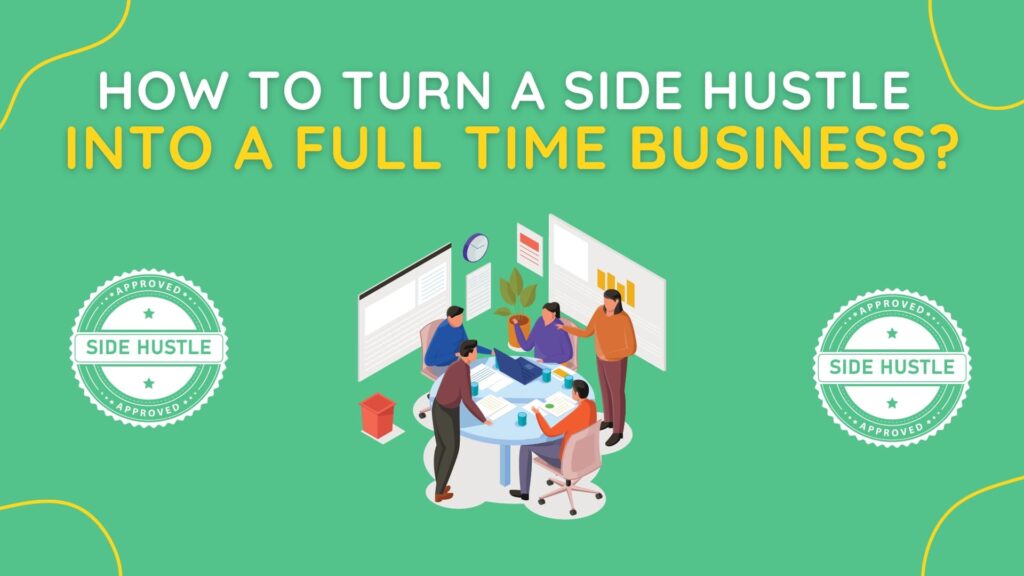
Sammie Ellard-King
I’m Sammie, a money expert and business owner passionate about helping you take control of your wallet. My mission with Up the Gains is to create a safe space to help improve your finances, cut your costs and make you feel good while doing it.

Quickfire Roundup:
It’s more possible to turn a side hustle into a full-time business. In fact, if you’ve made it this far then congratulations as it’s a big step!
If you want to make a living from your passions, my advice is to start by mapping out your goals and checking your current finances.
You’ll then need a detailed business plan, choose the right business structure, and finally, start your new business.
Over 30% of adults in the UK now have side hustles, which is expected to rise to almost 50% within the next year.
With its popularity growing so rapidly since the pandemic, many people are leaving their primary jobs behind and turning to creative side hustles full-time.
If you’re running a side hustle and things are going particularly well, you can turn it into a full-time business like many others have already.
Let’s dive into a step-by-step guide on how to turn a side hustle into a full time business.
I’ll explain how to map out your goals, the financial considerations to bear in mind, how to choose a business structure, and how to register your new company.
Table of Contents
When should I turn a side hustle into a full-time business?
First, let’s discuss timing – how do you know when to turn your side hustle into a full-time business? This depends on several things, such as how much money you earn from it.
Once your profits exceed £1,000 a year, you’ll need to notify HMRC and pay income tax on your additional income. At this point, it might be worth focusing on your side hustle full-time either as a sole trader or a limited company.
You should also think about how time-consuming your side hustle is, whether you can afford to leave your current job, and what your long-term objectives are.
Think about:
- How you’ll support yourself financially
- Whether you’d be going into business alone or someone else
- What support you might need when running a full-time business
- What expenses you expect to have
- Your motivations behind becoming a business owner
- Your entrepreneurial goals
- A back-up plan if it doesn’t work out
There’s certainly a lot to consider before turning a side hustle into a full-time business. If you’re ready to take the plunge, keep reading my step-by-step guide on how to set up your new business.
Listen to this 🎙️
Join us with Emma from BeeMoneySavvy for an episode all about side hustles turned into full time businesses.
You can get the full show notes and links to your favourite podcast platforms by clicking here or press play below and listen whilst you read!
Write a business plan
The first step is to write a comprehensive business plan. This document maps out your objectives, business strategy, marketing plans, and financial forecasts.
The purpose of a business plan is to get organised and visualise your journey.
Here’s a simple guide to writing a business plan:
Executive summary: This is where you pitch your business. State your business name, industry, and what your business does and what it aims to achieve.
Owner’s background: Explain why you want to start your own business. You have already done this exercise in step one of this guide. Be as detailed as possible and reflect your inspiration behind turning your side hustle into a full-time business.
Products and services: Describe what your business will do. Will you sell a product, provide a service, or both?
Audience and market research: Talk about your target audience here. Describe who they are, what the demand is for your product/service, and how you’ll stand out from the crowd.
Financial plans: Discuss factors like your marketing strategies and how much they’ll cost, the price point of your products/services, profit margins, and logistics costs. You should also look ahead and provide financial projections.
Competitors: You should have a clear understanding of your main competitors. In this section, note down what they do, their unique selling points (USPs), and how they compare to your business.
Writing a business plan is one of the most important steps to turning your side hustle into a full-time business. This is where you button down your long-term plans and how you’ll achieve them.
A business plan is also the fundamental tool when you’re crowdfunding, applying for a business loan, or thinking of bringing a business partner on board.
For more guidance on how to write your business plan, visit the Princes Trust.

Review your finances
As a new business owner, you’re likely to have a low income to start with. Until this point, your side hustle provided supplementary cash. Now that you’re going full-time, the aim is to turn it into your entire income.
So, you’ll need to review your finances. The purpose here is to understand how long your new business can survive before it needs more funding.
Research shows that over half of side hustlers earn between £500 and £2,500 a month.
This is unlikely to be substantial when starting a full-time business and you may even have to use your personal savings to get things off the ground.
For a smooth transition, it’s essential to plan how you will support yourself and your company in the early stages. Think about:
- Your current personal outgoings – are there any changes or cutbacks you need to make to be able to inject more money into your new business?
- Your rainy day fund – do you have any savings to protect yourself if things go wrong?
- Where you’re going to work – will it be from home or do you need to pay for an office space?
- Your business partner – are you starting your new business alone or with someone else?
- Whether you need a business loan
- Any equipment you might need to fund to run your business effectively
Choosing a business structure
The next step to turning your side hustle into a full-time business is to choose a business structure. This is a crucial step that will determine your company’s legal identity.
The main small business structures are:
Sole trader
A sole trader is a self-employed individual. As a sole trader, you’ll pay income tax on the profits that your business makes, which you’ll have to declare via an annual Self Assessment tax return. Depending on your profits, you may also be liable for National Insurance (NI) contributions.
Generally, it’s easy, flexible, and inexpensive to get started. There is no registration fee (unlike when incorporating a company) and less paperwork to do, you’re in complete control, and you can change your business structure at a later date.
You are also not regulated by the Companies Act 2006, meaning that you have no legal duties as a sole trader (unlike a director or shareholder).
However, the fact that you’re not regulated by the Act presents a higher financial risk. There is no legal separation between yourself and your business, so if it falls into debt or faces legal action, you are personally liable for the damage.
Limited company
There are 4 key limited company types: limited by shares, limited by guarantee, private, and public, all of which are governed and protected by the Act.
Unlike sole traders, a limited company is registered at Companies House and is its own legal entity. This means that you, as the owner, are not personally liable for the company’s finances.
As well as being the safer option, limited companies are also considerably more tax-efficient than sole traders.
You can choose how you pay yourself, how you utilise surplus income, and you pay lower Corporation Tax rates (versus higher income tax rates as a sole trader).
On the other hand, there is a small fee for incorporating a limited company. You can do this directly via Companies House or through 1st Formations.
Also, limited company directors and secretaries have ongoing legal obligations as per section 46 of the Companies Act 2006, which could lead to a range of penalties if fallen short.

Other business structures
If you’re running your side hustle with someone else and want to go full-time with a business partner, you may want to consider a partnership or a limited liability partnership (LLP) structure.
A partnership is similar to sole traders, whereby each partner registers as self-employed and completes their own Self Assessment tax returns. However, bear in mind that all partners are equally responsible for the company’s finances.
An LLP is, effectively, a cross between a partnership and a limited company. You need at least two partners and at least two designated members (they can be the same two people).
Those members have a limited liability. This means that if the company fails, falls into debt, or gets sued, each member is only liable for the face value of their share of the business.
Register your new business
Now, it’s time to register your full-time business. The registration process depends on the business structure you’ve chosen.
Sole traders (and partnerships) do not have to register with Companies House.
However, you do need to:
- Set up as self-employed
- Choose your trading name; and
- Register for Self Assessment
Setting up as a sole trader is free and you can start trading right away.
Limited companies (and LLPs) do need to register with Companies House. You can apply directly, which costs £12, or via a company formation agent. You’ll need to:
- Choose a name for your business
- Appoint directors, shareholders, and/or a company secretary
- Identify people with significant control (PSC)
- Prepare documents agreeing on how to run your company (articles of association); and
- Choose a Standard Industrial Classification (SIC) code(s)
You’ll usually be registered and ready to trade within 24 hours. Also, note that you’ll need to register for Corporation Tax within 3 months of incorporation.
You can find a step-by-step guide on how to set up a limited company, rules and regulations, and check which company records you’ll need to keep on the government website.

Next steps
Once you’ve officially turned your side hustle into a full-time business, you might want to start thinking about the next steps. For example, you may need to review your business insurance, making sure that you have the right level of cover for your structure and operations.
You should also consider any legal obligations you might need to fulfil as a director or sole trader. Or maybe it’s time to activate your marketing plans.
Remember that a new business needs care, attention, and time to flourish. Start small and focus on growing your company one step at a time.
FAQs
When should I turn my side hustle into a business?
Generally, if your side hustle is generating a promising income and you have solid savings to support yourself, these are positive signals that it might be time to turn your side hustle into a full-time business.
Once you earn £1,000 or more a year, you need to tell HMRC about your additional income. This can also be a useful indicator to focus on your side hustle.
How do I start a small side hustle business?
If you run your side hustle full-time as a sole trader, all you need to do is choose a trading name and register for Self Assessment. If you choose a limited company, however, you need to incorporate your business by registering with Companies House.
You register yourself or through a company formation agent, but there is a fee. You’ll need a name, appoint certain roles, and prepare several key documents.
There are several different business structures for your small business. Remember to do in-depth research and choose the one that’s most suitable for you.
Can a side hustle become a career?
Most definitely, and many people all over the world have made a career from a side hustle. If you are passionate about a hobby, have an entrepreneurial mindset, and are driven by being your own boss, your side hustle can become your career.
Be sure to evaluate how viable your side hustle is – check how much money it is bringing in, how in-demand your products/services are, and that you have the resources to turn your side hustle into a career.
How do I start a side business in the UK?
There are many different options if you’re just getting started.
Popular side hustles in the UK are:
- Selling pre-loved clothing on Vinted or Depop
- Selling hand-crafted goods on Etsy
- Delivery services with Deliveroo or Uber
- Freelancing
- Affiliate marketing
- Blogging
Before starting your side hustle, think about your skills, passions, and availability.
Conclusion
So, there you have my step-by-step guide to converting your side hustle into a full-time business. If you have just started your side hustle and are unsure when to take the plunge, I’d advise you to think about your motivations and long-term goals.
Once you start making more than £1,000 a year from your side hustle, this might also be a good time to focus on it full-time. Incorporation will give you significant tax-efficient options on your business income.
Share on social media
Disclaimer: Content on this page is for informational purposes and does not constitute financial advice. Always do your own research before making a financially related decision.


